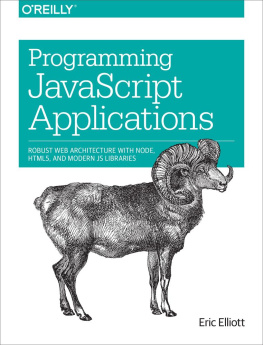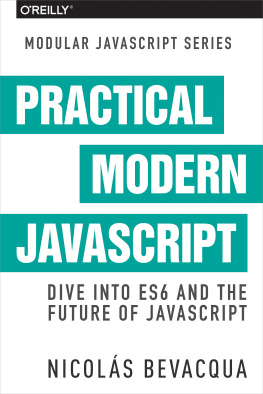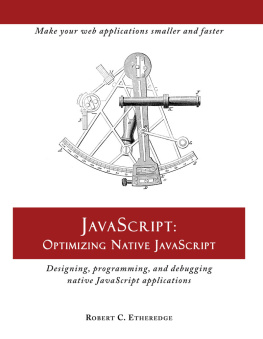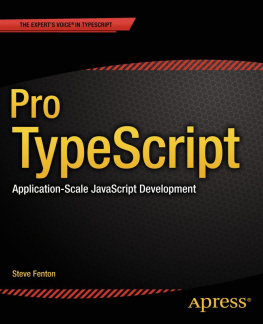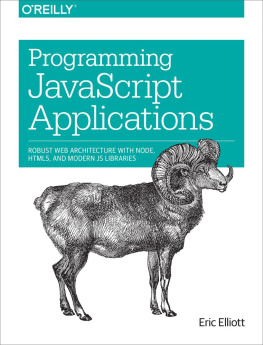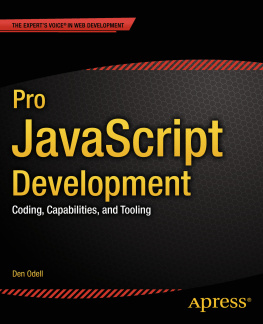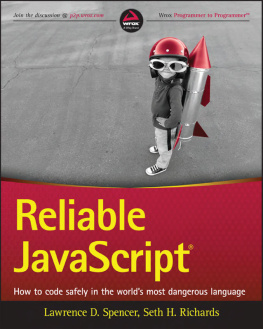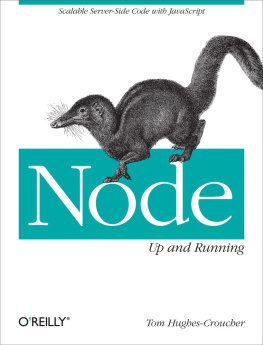Programming JavaScript Applications
Eric Elliott
Beijing Cambridge Farnham Kln Sebastopol Tokyo
Special Upgrade Offer
If you purchased this ebook directly from oreilly.com, you have the following benefits:
DRM-free ebooksuse your ebooks across devices without restrictions or limitations
Multiple formatsuse on your laptop, tablet, or phone
Lifetime access, with free updates
Dropbox syncingyour files, anywhere
If you purchased this ebook from another retailer, you can upgrade your ebook to take advantage of all these benefits for just $4.99. to access your ebook upgrade.
Please note that upgrade offers are not available from sample content.
Preface
Introduction
There are many books on the web technologies covered in this publication. However, there are precious few on JavaScript that can be recommended to somebody who wants to learn how to build a complete JavaScript application from the ground up. Meanwhile, almost every new tech startup needs knowledgeable JavaScript application developers on staff. This book exists for one purpose: to help you gain the knowledge you need to build complete JavaScript applications that are easy to extend and maintain.
This book is not intended to teach you the basics of JavaScript. Instead, its designed to build on your existing knowledge and discuss JavaScript features and techniques that will make your code easier to work with over time. Normally, as an application grows, it becomes increasingly difficult to add new features and fix bugs. Your code becomes too rigid and fragile, and even a small change could necessitate a lengthy refactor. If you follow the patterns outlined in this book, your code will remain flexible and resilient. Changes to one piece of code wont negatively impact another.
This book will focus primarily on client-side architecture, although it will also cover server-side topics, such as basic RESTful APIs and Node. The trend is that a great deal of the application logic is getting pushed to the client. It was once the case that the server environment would handle things like templating and communication with vendor services. Now, its common to deal with both of those jobs inside the browser.
In fact, a modern JavaScript application does almost everything a traditional desktop app would do completely in the browser. Of course, servers are still handy. Server roles frequently include serving static content and dynamically loaded modules, data persistence, action logging, and interfacing with third-party APIs.
Well cover:
JavaScript features and best practices for application developers
Code organization, modularity, and reuse
Separation of concerns on the client side (MVC, etc.)
Communicating with servers and APIs
Designing and programming RESTful APIs with Node.js
Building, testing, collaboration, deployment, and scaling
Expanding reach via internationalization
Who This Book Is For
You have some experience with JavaScript; at least a year or two working frequently with the language, but you want to learn more about how you can apply it specifically to developing robust web-scale or enterprise applications.
You know a thing or two about programming, but you have an insatiable thirst to learn more. In particular, youd like to learn more about how to apply the powerful features that distinguish JavaScript from other languages, such as closures, functional programming, and prototypal inheritance (even if this is the first youve heard of them).
Perhaps youd also like to learn about how to apply test-driven development (TDD) techniques to your next JavaScript challenge. This book uses tests throughout the code examples. By the time you reach the end, you should be in the habit of thinking about how youll test the code you write.
Who This Book Is Not For
This book covers a lot of ground quickly. It was not written with the beginner in mind, but if you need clarification, you might find it in JavaScript: The Good Parts , by Douglas Crockford (OReilly, 2008), JavaScript: The Definitive Guide , by David Flannagan (OReilly, 2011), or for help with software design patterns, the famous Gang of Four book (GoF), Design Patterns: Elements of Reusable Object-Oriented Software , by Erich Gamma, Richard Helm, Ralph Johnson, and John Vlissides (Addison-Wesley, 1994).
Google and Wikipedia can be handy guides to help you through, as well. Wikipedia is a fairly good reference for software design patterns.
If this is your first exposure to JavaScript, you would do well to study some introductory texts and tutorials before you attempt to tackle this book. My favorite is so that you can learn from the mistakes made by more experienced JavaScript developers.
Unit Testing
Its difficult to overstate the importance of unit testing. Unit tests are used throughout this book. By the time you reach the end, you should be accustomed to seeing and writing them. As you practice the concepts you read about, start by writing the tests first. Youll get a better understanding of the problem domain, and youll be forced to think through the design for your solution and the interface you create for it. Designing for unit tests also forces you to keep your code decoupled. The discipline of writing testable, decoupled code will serve you well your entire career.
For a reference on unit tests and code style, see .
Conventions Used in This Book
The following typographical conventions are used in this book:
Italic
Indicates new terms, URLs, email addresses, filenames, and file extensions.
Constant widthUsed for program listings, as well as within paragraphs to refer to program elements such as variable or function names, databases, datatypes, environment variables, statements, and keywords.
Constant width boldShows commands or other text that should be typed literally by the user.
Constant width italicShows text that should be replaced with user-supplied values or by values determined by context.
Tip
This icon signifies a tip, suggestion, or general note.
Caution
This icon indicates a warning or caution.
Safari Books Online
Note
Safari Books Online is an on-demand digital library that lets you easily search over 7,500 technology and creative reference books and videos to find the answers you need quickly.
With a subscription, you can read any page and watch any video from our library online. Read books on your cell phone and mobile devices. Access new titles before they are available for print, and get exclusive access to manuscripts in development and post feedback for the authors. Copy and paste code samples, organize your favorites, download chapters, bookmark key sections, create notes, print out pages, and benefit from tons of other time-saving features.
OReilly Media has uploaded this book to the Safari Books Online service. To have full digital access to this book and others on similar topics from OReilly and other publishers, sign up for free at http://my.safaribooksonline.com.
How to Contact Us
Please address comments and questions concerning this book to the publisher:

